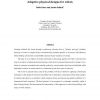Free Online Productivity Tools
i2Speak
i2Symbol
i2OCR
iTex2Img
iWeb2Print
iWeb2Shot
i2Type
iPdf2Split
iPdf2Merge
i2Bopomofo
i2Arabic
i2Style
i2Image
i2PDF
iLatex2Rtf
Sci2ools
ALIFE
1998
1998
Evolutionary Body Building: Adaptive Physical Designs for Robots
Creating artificial life forms through evolutionary robotics faces a “chicken and egg” problem: learning to control a complex body is dominated by problems specific to its sensors and effectors, while building a body that is controllable assumes the pre-existence of a brain. The idea of co-evolution of bodies and brains is becoming popular, but little work has been done in evolution of physical structure because of the lack of a general framework for doing it. Evolution of creatures in simulation has usually resulted in virtual entities which are not buildable, while embodied evolution in actual robotics is constrained by the slow pace of real time. The work we present takes a step in the problem of body evolution by applying evolutionary techniques to the design of structures assembled out of elementary components which stick together. Evolution takes place in a simulator which computes forces and stresses and predicts stability of 3dimensional brick structures. The final prin...
| Added | 21 Dec 2010 |
| Updated | 21 Dec 2010 |
| Type | Journal |
| Year | 1998 |
| Where | ALIFE |
| Authors | Pablo Funes, Jordan B. Pollack |
Comments (0)

